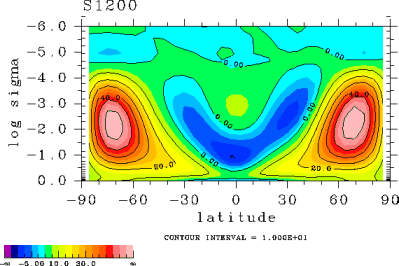E. Atmospheric Structure in Equilibrium States |
h. Zonal Wind Distribution (Upper Layer)
Figure 1 shows the meridional distribution of the zonal wind in equilibrium states. The figure for Experiment S1380 reveals the presence of an atmospheric structure that includes easterlies near the equator, subtropical jets, and polar night jets, and thus appears to match the actual Earth's atmospheric structure. However, because of the application of vertical filtering, the axes of the subtropical and polar jets are blurred, which makes it difficult to identify the positions of jet axes and the strengths of the jets . Furthermore, westerlies and easterlies form over the equator and mid-latitudes, respectively. No investigation has been made on the cause of the formation of the westerlies over the equator, but they may be attributable to the propagation of gravity waves originating from the troposphere or emission of Rossby waves from the equatorial region toward mid-latitudes.
The strength of the westerlies above the equator increases with increasing solar constant. The subtropical and polar night jets shift to higher layers with an increasing solar constant. However, in Experiments S1550 and S1570, the polar night jets have the appearance of being crushed due to the effects of the damping layer.

Figure 1:Distributions of the zonal wind (m/sec) in the equilibrium states.